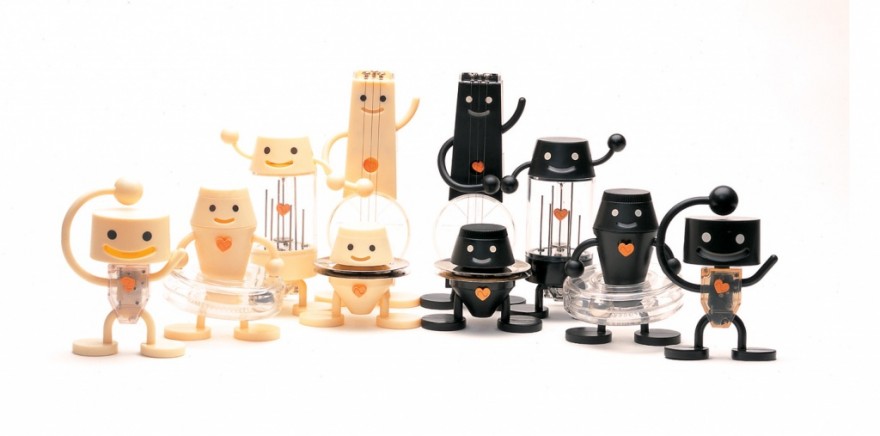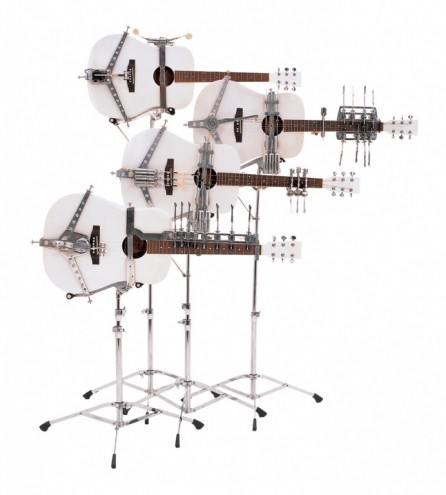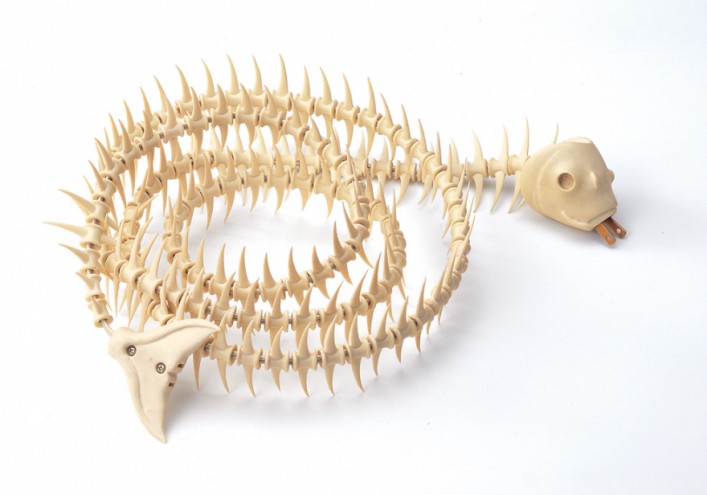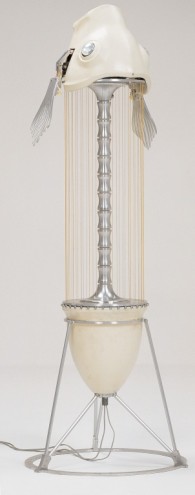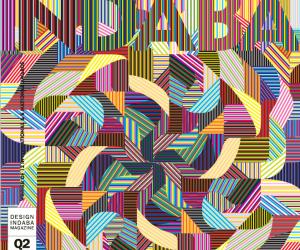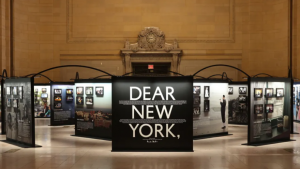First Published in
Singing robots, fish spine power cables, remote-controlled acoustic guitars and tap shoes, and machines that pop all the bubbles in a sheet of bubble wrap at once. Fish-eye lens goggles, musical wings operated by finger snappers, toy tractors that are guided by swimming fish and, well, electric musical saws… Don't worry, you’re not supposed to “get it”.
Want to know the time? Japanese artist Nobumichi Tosa wiggles his black framed spectacles at you, raises his wristwatch to reveal a rotary dial phone clock, dials the code for the Japanese time service and is told the time by a recorded electronic voice. With more than 300 hand-built computer-controlled nonsense machines to his credit, I’m still to be convinced that the voice says anything other than: “It’s time for nonsense.”
Just to set the record straight: “Nonsense” is not a derogatory term in relationship to Tosa, in fact he claims it as his artistic imperative. It’s easy to interpret this as a response to the question of what does one make for a world that has everything? However, in speaking to him, Tosa refuses to give in to interpretation or social speculation, instead radiating the speculative power of nonsense.
Who is Nobumichi Tosa and how did you grow up?
I decided to be an artist when I was in kindergarten and willed that into being right until I started studying art at Tsukuba University in Japan. Meanwhile, my father ran an electrical company called Maywa Denki and so my house was like a factory. I think my hunch for engineering was nurtured in this environment.
Also, my family love music and there have always been musical instruments around me since I was a child. In junior high school, I played percussion in a brass band, and in high school I played the drums in a band.
If you had to meet someone who has never seen or heard of Maywa Denki, how would you explain it?
A strange Japanese manufacturer that makes completely useless machines with absolute technical precision and introduces them with a sophisticated presentation.
You started Maywa Denki with your brother in 1993. Why and how did you start Maywa Denki?
I made the fish motif nonsense machines called NAKI as completion of my Masters degree at Tsukuba University. However, in Japan artists are not really recognised by the public. It was hard for me to introduce my works as an artist.
But suddenly I remembered my father’s electrician job. For me, that electrician style was interesting for a number of reasons:
• It gets along well with my mechanical works.
• The Japanese are somewhat authoritarian and so easily trust someone in uniform.
• The Japanese are more like engineers and inventors than artists.
• A lot of techno musicians wear uniforms, such as Kraftwerk.
There was another important reason, which was my relationship with my father. Since his Maywa Denki went out of business when I was in primary school, we lived apart and hardly met. I think I was always ignoring him somewhere in my heart. But when I grew up to the age that my father was when he founded Maywa Denki, I decided to seriously face these personal taboos of my father and Maywa Denki. This was the primary reason I took the Maywa Denki style for my activities.
At the time, my brother was a part-time worker and I asked him if he would do this with me. When we were in high school, he and I put a computer music band together and participated in contests held by Yamaha, so our collaboration was nothing new. Finally he agreed and Maywa Denki started.
Your brother retired from Maywa Denki in 2001. How has Maywa Denki changed since you became president?
Before my brother retired, he was the publicist and I was the developer. But since he left, I had to be out in public more and I have had to become more outgoing. Also, I started developing the EDELWEISS series. And Maywa Denki shifted from a purely music-orientated line to include the development of toys and gadgets, and began to spread overseas.
You insist on calling yourself an artist, but each of your art works is called a “product” and your performances are called “product demonstrations”. What to you is the difference between art and design, and what are you saying about society through this?
Artists “dig out” personal “artistic resources”, just like pumping oil up from an oilfield. We “purify” them by our technique and turn it into art. We put our will into “recognising ourselves” before “commercial success”.
By contrast, designers “purify” “commercial resources” that companies have already developed. And they must “sell well”, first of all.
Your musical instruments in particular are fascinating and seem to be the core of your creative output. The instruments often present robotic ways of playing instruments that are traditionally perceived as only playable by humans. Other times they process environmental sounds and reinterpret them through knockers, digital organs or fish harps. Please explain your artistic fascination and relationship with sound.
I became aware of the synthesiser when I was in primary school and committed myself to making computer music. However, as musical instruments increasingly became digitalised, music became about just manipulating information. It didn’t attract me any more.
Meanwhile, my percussion skills started developing during junior high school. The most fascinating thing about percussion is that you communicate directly with materials.
One day I got the idea to combine the fun of computer music and the fun of percussion as a material, and developed the knocker. Like this, Maywa Denki tries to always make things that are “analogue beyond digital”.
You sometimes also refer to your art works or products as “nonsense machines”. What is the significance of nonsense in the modern world?
I recognise nonsense not as “denying commonsense and messing up orders”, but as “transcending commonsense and establishing a new order”.
The history of life evolution has always been lead by such nonsense pioneers, and so the fishes finally succeeded in evolving to flying birds in the sky. Creativity is nonsense. And I think nonsense activities are the only solution to how modern society can evolve to the next stage.
Your NAKI series is based on various interpretations of fish, but the fish motif also crops up in your TSUKUBA series of original musical instruments. What is your fascination with fish?
I often have bad dreams about fish. To me, fish is pathos in very deep psychology, which I can’t understand. But this pathos gives me huge energy to make works.
At Design Indaba, you had the audience in stitches of laughter. Humour is a powerful creative tool that often masks a difficult message. What is your message to the world?
Change the world with your original “new standard”.
How do you feel about the world’s relationship with technology? What should the world be doing with technology?
Don’t use it for destroying, use it for creation.

